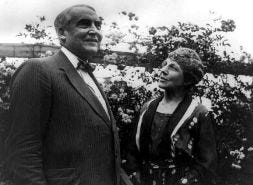Warren and Florence Harding in the garden. Public domain, via Wikimedia Commons
Watching the unfolding 2024 presidential election, there is a lot of commentary about the candidates as a popular culture phenomenon. This is fair enough, but this is not a new thing. As I have pointed out elsewhere, presidents have always had cultural sway. The rise of mass media and popular culture only increased it.
Another conversation around the 2024 election centers on the importance of swing states in the electoral college. Clearly, an important topic for understanding the eventual outcome of the election. Also, a topic that is not new.
An historical artifact linking the worlds of presidents as symbolic leaders and cultural icons and the world of hard-core electorial vote counting is a map of presidential commemorative sites. In the world of presidential tourism, the states which have produced the most presidents is a thing. It is often at these sites that visitors find the vestiges of regional identity and popular culture appeal that informed candidates and presidents. You can visit the Vermont farm where Calvin Coolidge grew up and took the oath of office and the Ohio front porches James Garfield, William McKinley and Warren Harding campaigned from. At Hyde Park you can see Franklin Roosevelt’s stamp collection. So forth and so on as these sites ground former presidents in a place and a time. For visitors, these can sometimes overshadow the president’s policies.
The locations also reflect actual the dynamics that helped the person rise to the presidency.
During the early republic, Virginia was the largest state and as such dominated the presidency with George Washington, Thomas Jefferson, James Madison, James Monroe, William Henry Harrison, John Tyler and Zachery Taylor. Woodrow Wilson is also on the Virginia list, where he was born, but he became president in the 20th century via the New Jersey governorship. As such, Wilson was the first southern elected to the presidency after the Civil War.
Ohio dominated the presidency during the Gilded Age reflecting the old truism that no Republican has won the White House without Ohio. Booming with industry, Ohio had a large number of electoral votes and was a swing state. The need to carry Ohio meant that candidates from Ohio had an advantage in the nominating process. Thus Ohio’s landscape is dotted with presidential museums, graves, and homes.
The calculus of nominating an important state’s native hasn’t gone completely away (Biden was born in the swing state of Pennsylvania) but with a Democratic Californian running against a Republican New Yorker who moved to Florida, maybe some of the old math doesn’t work anymore. Californian being solidly Democratic and Florida being solidly Republican. The same is true for the vice presidential candidates. It seems entirely possible that popular mass culture combined with our polarizing culture wars has diminished the importance of a candidate's hometown.



